Facile Fabrication of Thin-Bottom Round-Well Plates Using the Deformation of PDMS Molds and Their Application for Single-Cell PCR
Abstract
1. Introduction
2. Principle and Mold Design
2.1. Principle for Fabrication of Thin Well Bottoms with Small Dimensional Error
2.2. Design of PDMS Mold
3. Materials and Methods
3.1. Construction of the PDMS Mold
3.2. Fabrication of Multi-Well Plate
3.3. Characterization of the PDMS Membrane, Mold, and Polycarbonate Product
3.4. Monitoring of PCR Temperature
3.5. Strain and Cell Culture
3.6. Single-Cell PCR
3.7. Evaluation of PCR
4. Results and Discussion
4.1. Characterization of the Mold
4.2. Characterization of the Multi-Well Plate
4.3. Compensation of PCR Program
4.4. Cell Observation and Counting
4.5. Single-Cell PCR
5. Conclusions
Supplementary Materials
Author Contributions
Funding
Acknowledgments
Conflicts of Interest
References
- Chun, D.H. Numerical analysis of injection molding for the Syringe Barrel with optimum design and processing condition. Fibers Polym. 2017, 18, 1790–1795. [Google Scholar] [CrossRef]
- Yonehata, Y.; Maeda, Y.; Machi, H.; Sakaguchi, R.L. The influence of working cast residual moisture and temperature on the fit of vacuum-forming athletic mouth guards. J. Prosthet. Dent. 2003, 89, 23–27. [Google Scholar] [CrossRef] [PubMed]
- Kikuchi, M.; Tanaka, J.; Koyama, Y.; Takakuda, K. Cell culture test of TCP/CPLA composite. J. Biomed. Mater. Res. 1999, 48, 108–110. [Google Scholar] [CrossRef]
- Yamamura, S.; Kishi, H.; Tokimitsu, Y.; Kondo, S.; Honda, R.; Rao, S.R.; Omori, M.; Tamiya, E.; Muraguchi, A. Single-cell microarray for analyzing cellular response. Anal. Chem. 2005, 77, 8050–8056. [Google Scholar] [CrossRef]
- Dusseiller, M.R.; Schlaepfer, D.; Koch, M.; Kroschewski, R.; Textor, M. An inverted microcontact printing method on topographically structured polystyrene chips for arrayed micro-3-D culturing of single cells. Biomaterials 2005, 26, 5917–5925. [Google Scholar] [CrossRef]
- Furutani, S.; Naruishi, N.; Hagihara, Y.; Nagai, H. Development of an on-site rapid real-time polymerase chain reaction system and the characterization of suitable DNA polymerases for TaqMan probe technology. Anal. Bioanal. Chem. 2016, 408, 5641–5649. [Google Scholar] [CrossRef]
- Chen, Y.W.; Wang, H.; Hupert, M.; Witek, M.; Dharmasiri, U.; Pingle, M.R.; Barany, F.; Soper, S.A. Modular microfluidic system fabricated in thermoplastics for the strain-specific detection of bacterial pathogens. Lab Chip 2012, 12, 3348–3355. [Google Scholar] [CrossRef]
- Park, D.; Lee, J.; Chung, J.J.; Jung, Y.; Kim, S.H. Integrating organs-on-chips: Multiplexing, scaling, vascularization, and innervation. Trends Biotechnol. 2020, 38, 99–112. [Google Scholar] [CrossRef]
- Nakao, Y.; Kimura, H.; Sakai, Y.; Fujii, T. Bile canaliculi formation by aligning rat primary hepatocytes in a microfluidic device. Biomicrofluidics 2011, 5, 22212. [Google Scholar] [CrossRef]
- Luo, J.; Chen, C.; Li, Q. White blood cell counting at point-of-care testing: A review. Electrophoresis 2020. [Google Scholar] [CrossRef]
- Suzuki, M.; Yoshimoto, N.; Shimono, K.; Kuroda, S. Deciphering the receptor repertoire encoding specific odorants by time-lapse single-cell array cytometry. Sci. Rep. 2016, 6, 19934. [Google Scholar] [CrossRef] [PubMed]
- Xin, Y.; Kim, J.; Ni, M.; Wei, Y.; Okamoto, H.; Lee, J.; Adler, C.; Cavino, K.; Murphy, A.J.; Yancopoulos, G.D.; et al. Use of the Fluidigm C1 platform for RNA sequencing of single mouse pancreatic islet cells. Proc. Natl. Acad. Sci. USA 2016, 113, 3293–3298. [Google Scholar] [CrossRef]
- Dong, X.; Gao, D.; Dong, J.; Chen, W.; Li, Z.; Wang, J.; Liu, J. Mass ratio quantitative detection for kidney bean in lotus seed paste using duplex droplet digital PCR and chip digital PCR. Anal. Bioanal. Chem. 2020, 412, 1701–1707. [Google Scholar] [CrossRef] [PubMed]
- Koizumi, Y.; Furuya, D.; Endo, T.; Asanuma, K.; Yanagihara, N.; Takahashi, S. Quantification of Wilms’ tumor 1 mRNA by digital polymerase chain reaction. Int. J. Hematol. 2018, 107, 230–234. [Google Scholar] [CrossRef] [PubMed]
- White, A.K.; VanInsberghea, M.; Petriva, O.I.; Hamidia, M.; Sikorskia, D.; Marrae, M.A.; Piretc, J.; Apariciof, S.; Hansena, C.L. High-throughput microfluidic single-cell RT-qPCR. Proc. Natl. Acad. Sci. USA 2011, 108, 13999–14004. [Google Scholar] [CrossRef] [PubMed]
- Wang, L.; Yu, P.; Zhou, B.; Song, J.; Li, Z.; Zhang, M.; Guo, G.; Wang, Y.; Chen, X.; Han, L.; et al. Single-cell reconstruction of the adult human heart during heart failure and recovery reveals the cellular landscape underlying cardiac function. Nat. Cell Biol. 2020, 22, 108–119. [Google Scholar] [CrossRef]
- Jung, W.C.; Heo, Y.M.; Yoon, G.S.; Shin, K.H.; Chang, S.H.; Kim, G.H.; Cho, M.W. Micro machining of injection mold inserts for fluidic channel of polymeric biochips. Sensors 2007, 7, 1643–1654. [Google Scholar] [CrossRef]
- Gao, P.; Liang, Z.; Wang, X.; Zhou, T.; Xie, J.; Li, S.; Shen, W. Fabrication of a micro-lens array mold by micro ball end-milling and its hot embossing. Micromachines 2018, 9, 96. [Google Scholar] [CrossRef]
- Konishi, S.; Shimomura, S.; Tajima, S.; Tabata, Y. Implementation of soft microfingers for a hMSC aggregate manipulation system. Microsyst. Nanoeng. 2016, 2, 15048. [Google Scholar] [CrossRef]
- Yamada, K.; Yamada, M.; Maki, H.; Itoh, K.M. Fabrication of arrays of tapered silicon micro-/nano-pillars by metal-assisted chemical etching and anisotropic wet etching. Nanotechnology 2018, 29, 28LT01. [Google Scholar] [CrossRef]
- Evens, T.; Malek, O.; Castagne, S.; Seveno, D.; Van Bael, A. A novel method for producing solid polymer microneedles using laser ablated moulds in an injection moulding process. Manuf. Lett. 2020, 24, 29–32. [Google Scholar] [CrossRef]
- Lin, X.; Dou, X.; Wang, X.; Chen, R.T. Nickel electroplating for nanostructure mold fabrication. J. Nanosci. Nanotechnol. 2011, 11, 7006–7010. [Google Scholar] [CrossRef] [PubMed]
- Song, Y.; Yan, Y.; Zhang, R.; Lu, Q.; Xu, D. Three dimensional non-linear coupled thermo-mechanical FEM analysis of the dimensional accuracy for casting dies in rapid tooling. Finite Elem. Anal. Des. 2001, 38, 79–91. [Google Scholar] [CrossRef]
- Maher, S.P.; Conway, A.J.; Roth, A.; Adapa, S.R.; Cualing, P.; Andolina, C.; Hsiao, J.; Turgeon, J.; Chaumeau, V.; Johnson, M.; et al. An adaptable soft-mold embossing process for fabricating optically-accessible, microfeature-based culture systems and application toward liver stage antimalarial compound testing. Lab Chip 2020, 20, 1124–1139. [Google Scholar] [CrossRef]
- Kim, M.; Moon, B.U.; Hidrovo, C.H. Enhancement of the thermo-mechanical properties of PDMS molds for the hot embossing of PMMA microfluidic devices. J. Micromech. Microeng. 2013, 23, 95024. [Google Scholar] [CrossRef]
- Fanzio, P.; Chang, C.T.; Skolimowski, M.; Tanzi, S.; Sasso, L. Fully-polymeric pH sensor realized by means of a single-step soft embossing technique. Sensors 2017, 17, 1169. [Google Scholar] [CrossRef]
- Park, J.M.; Gan, Z.; Leung, W.Y.; Liu, R.; Ye, Z.; Constant, K.; Shinar, J.; Shinar, R.; Ho, K.M. Soft holographic interference lithography microlens for enhanced organic light emitting diode light extraction. Opt. Express 2011, 19 (Suppl. S4), 786–792. [Google Scholar] [CrossRef]
- Chen, J.; Gu, C.; Lin, H.; Chen, S.C. Soft mold-based hot embossing process for precision imprinting of optical components on non-planar surfaces. Opt. Express 2015, 23, 20977–20985. [Google Scholar] [CrossRef]
- Liu, Y.; Zhang, P.; Deng, Y.; Hao, P.; Fan, J.; Chi, M.; Wu, Y. Polymeric microlens array fabricated with PDMS mold-based hot embossing. J. Micromech. Microeng. 2014, 24, 95028. [Google Scholar] [CrossRef]
- Yao, S.; Zhou, Z.; He, G.; Zhang, K.; Huang, X.; Qiu, B.; Sun, D. A microfluidically controlled concave–convex membrane lens using an addressing operation system. Microsyst. Nanoeng. 2020, 6, 34. [Google Scholar] [CrossRef]
- Jin, C.; Ma, C.; Yang, Z.; Lin, H. A force measurement method based on flexible PDMS grating. Appl. Sci. 2020, 10, 2296. [Google Scholar] [CrossRef]
- Osama, A.; Lou, L.Y.; Muhammad, Y.; Li, C.J.; Li, C.X. Enhanced Tribological Properties of LA43M Magnesium Alloy by Ni60 Coating via Ultra-High-Speed Laser Cladding. Coatings 2020, 10, 638. [Google Scholar]
- Svec, D.; Andersson, D.; Pekny, M.; Sjöback, R.; Kubista, M.; Ståhlberg, A. Direct cell lysis for single-cell gene expression profiling. Front. Oncol. 2013, 3, 274. [Google Scholar] [CrossRef]
- Le, A.V.; Huang, D.; Blick, T.; Thompson, E.W.; Dobrovic, A. An optimised direct lysis method for gene expression studies on low cell numbers. Sci. Rep. 2015, 5, 12859. [Google Scholar] [CrossRef] [PubMed]
- Hakhverdyan, M.; Hägglund, S.; Larsen, L.E.; Belák, S. Direct detection of infectious bursal disease virus from clinical samples by in situ reverse transcriptase-linked polymerase chain reaction. Avian Pathol. 2005, 37, 457–461. [Google Scholar]
- Segaliny, A.I.; Li, G.; Kong, L.; Ren, C.; Chen, X.; Wang, J.K.; Baltimore, D.; Wu, G.; Zhao, W. Functional TCR T cell screening using single-cell droplet microfluidics. Lab Chip 2018, 18, 3733–3749. [Google Scholar] [CrossRef]
- Lin, Q.; Zhao, J.; Song, Y.; Liu, D. Recent updates on CAR T clinical trials for multiple myeloma. Mol. Cancer 2019, 18, 154. [Google Scholar] [CrossRef]
- Reiter, J.G.; Baretti, M.; Gerold, J.M.; Makohon-Moore, A.P.; Daud, A.; Iacobuzio-Donahue, C.A.; Azad, N.S.; Kinzler, K.W.; Nowak, M.A.; Vogelstein, B. An analysis of genetic heterogeneity in untreated cancers. Nat. Rev. Cancer 2019, 19, 639–650. [Google Scholar] [CrossRef]
- Lim, S.B.; Yeo, T.; Lee, W.D.; Bhagat, A.A.S.; Tan, S.J.; Tan, D.S.W.; Lim, W.T.; Lim, C.T. Addressing cellular heterogeneity in tumor and circulation for refined prognostication. Proc. Natl. Acad. Sci. USA 2019, 116, 17957–17962. [Google Scholar] [CrossRef]
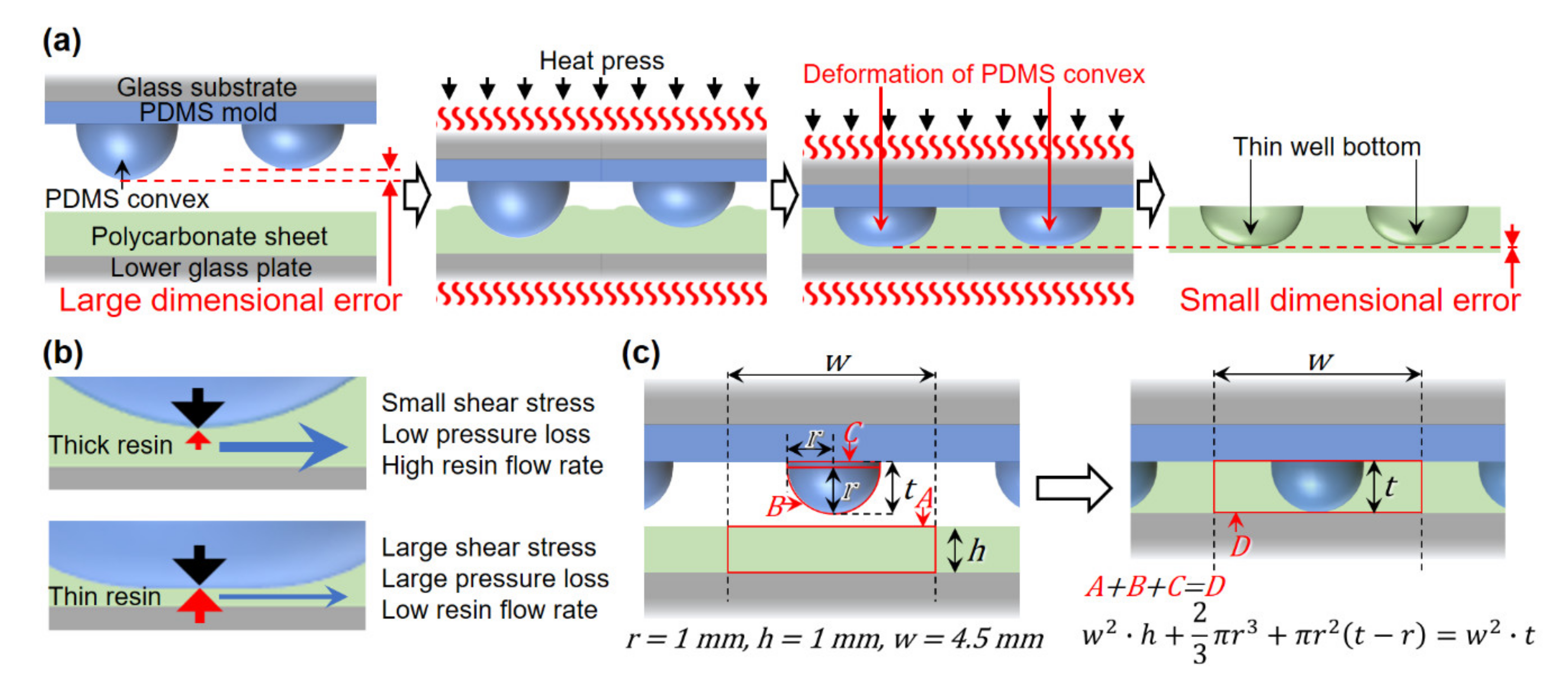
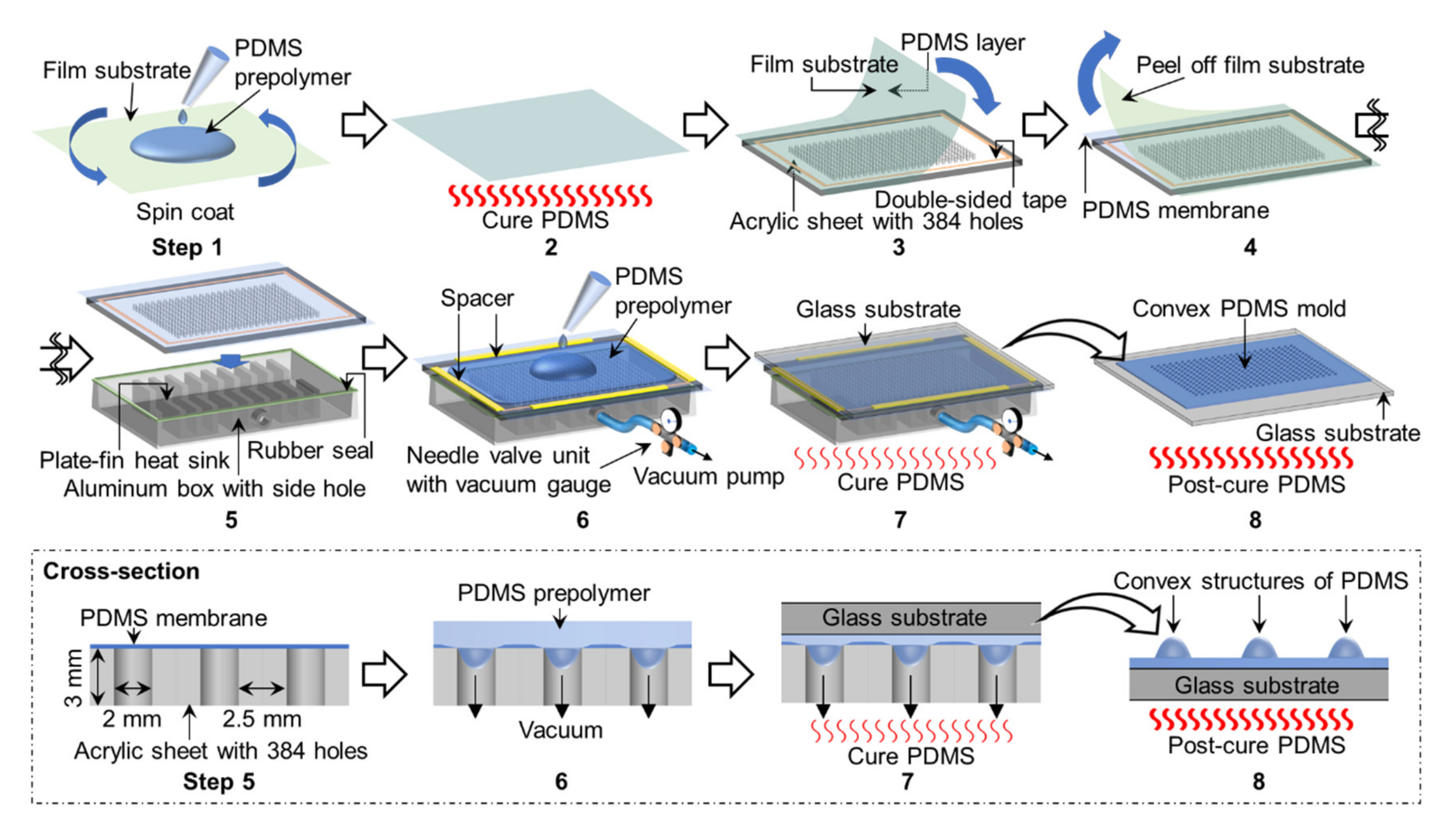
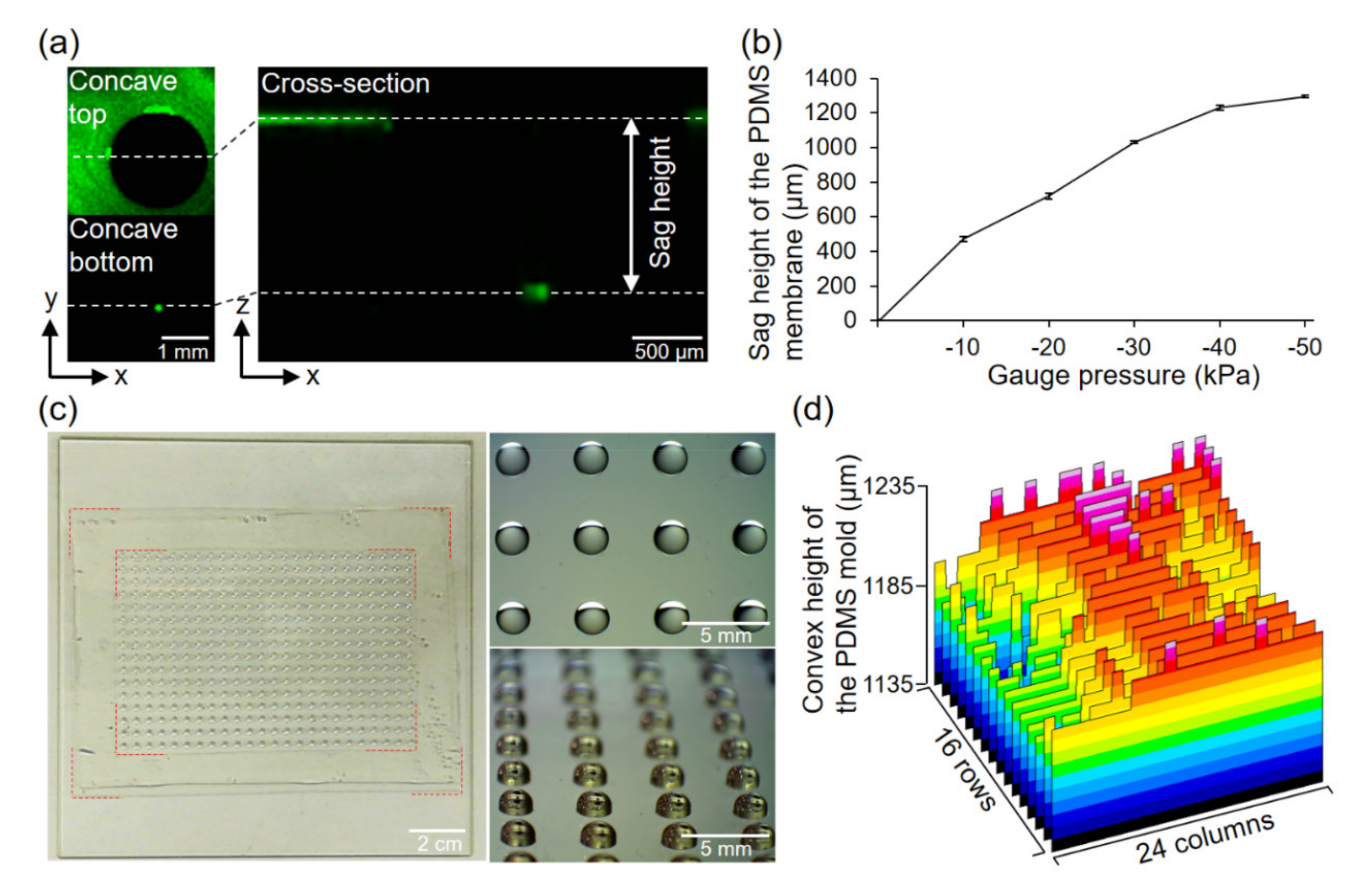
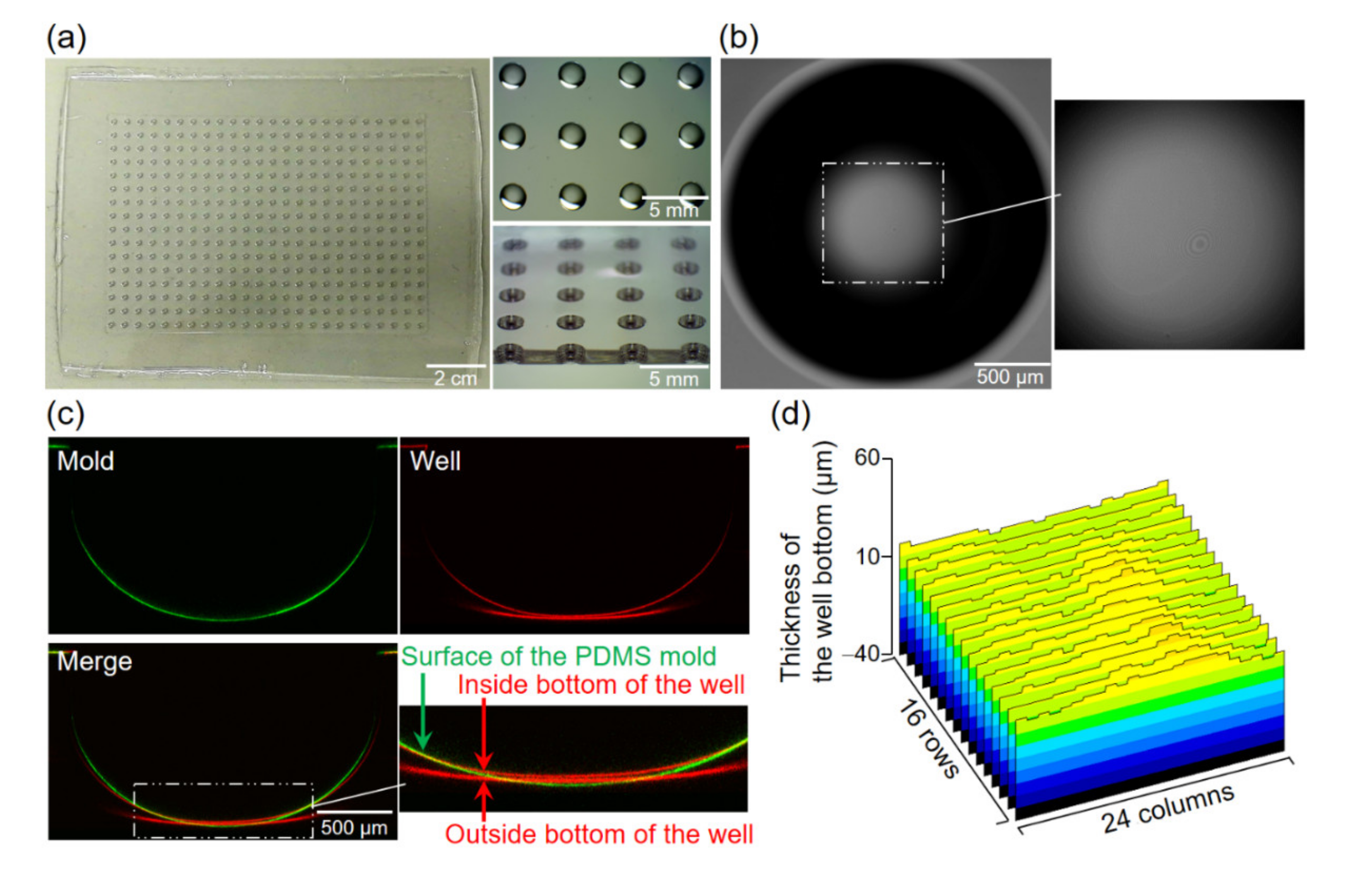

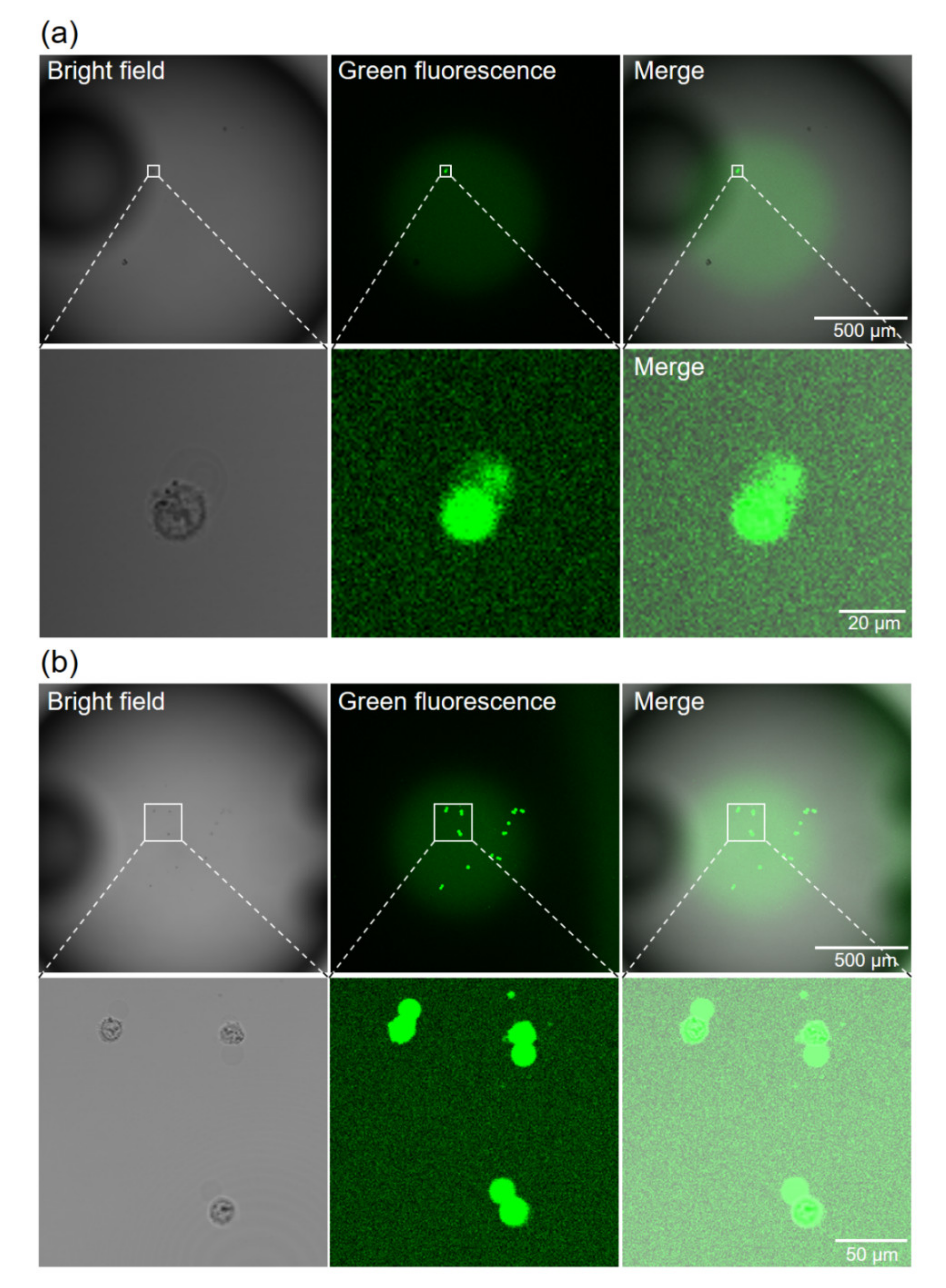
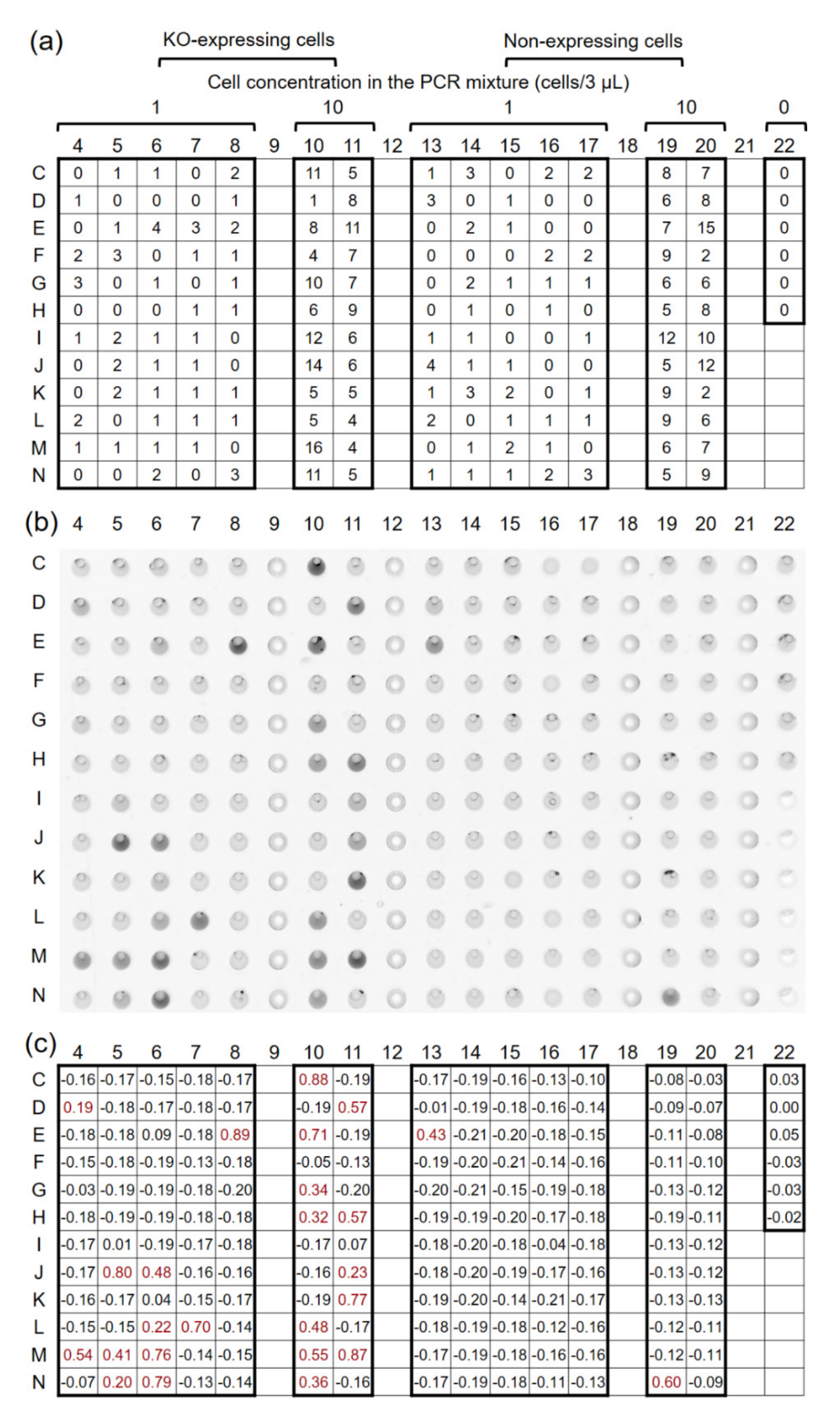
| PCR Condition | 1 Cell/3 µL in Well | 10 Cells/3 µL in Well | 10 Cells/20 µL in Tube | ||||
|---|---|---|---|---|---|---|---|
| KO expressing | Yes | Yes | No | Yes | No | Yes | No |
| Cells/well | 1 | 0 | 0.98 1 | 7.5 1 | 7.5 1 | N.A. | N.A. |
| Wells | 26 | 21 | 60 | 24 | 24 | 24 | 24 |
| (False) Positive wells | 7 | 1 | 1 | 12 | 1 | 13 | 1 |
| (False) Positive rate (%) | 26.9 | 2.5 | 50.0 | 4.2 | 54.2 | 4.2 | |
© 2020 by the authors. Licensee MDPI, Basel, Switzerland. This article is an open access article distributed under the terms and conditions of the Creative Commons Attribution (CC BY) license (http://creativecommons.org/licenses/by/4.0/).
Share and Cite
Yamahira, S.; Heike, Y. Facile Fabrication of Thin-Bottom Round-Well Plates Using the Deformation of PDMS Molds and Their Application for Single-Cell PCR. Micromachines 2020, 11, 748. https://doi.org/10.3390/mi11080748
Yamahira S, Heike Y. Facile Fabrication of Thin-Bottom Round-Well Plates Using the Deformation of PDMS Molds and Their Application for Single-Cell PCR. Micromachines. 2020; 11(8):748. https://doi.org/10.3390/mi11080748
Chicago/Turabian StyleYamahira, Shinya, and Yuji Heike. 2020. "Facile Fabrication of Thin-Bottom Round-Well Plates Using the Deformation of PDMS Molds and Their Application for Single-Cell PCR" Micromachines 11, no. 8: 748. https://doi.org/10.3390/mi11080748
APA StyleYamahira, S., & Heike, Y. (2020). Facile Fabrication of Thin-Bottom Round-Well Plates Using the Deformation of PDMS Molds and Their Application for Single-Cell PCR. Micromachines, 11(8), 748. https://doi.org/10.3390/mi11080748




